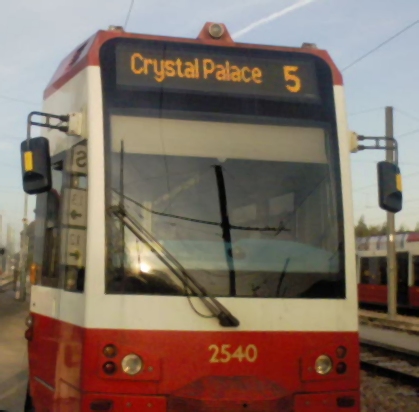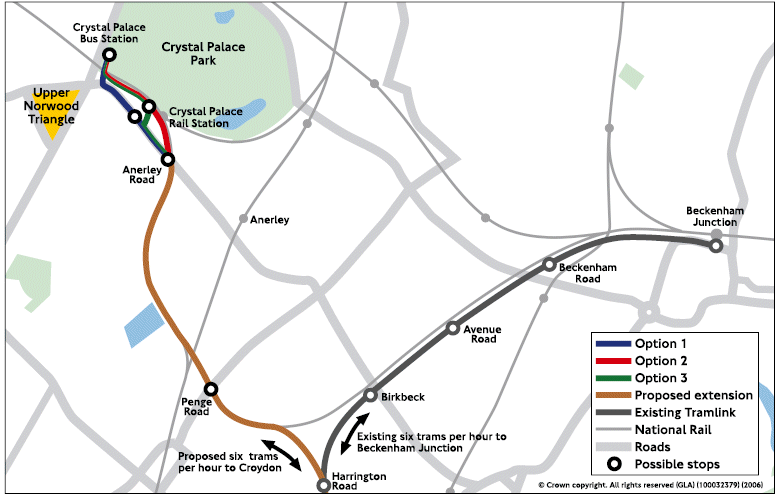|
||||||||||||
|
Home | ||||||||||||
  
|
||
|
|
||
|
Tramlink
Extensions |
||
|
TEMPORARY PAGE - more will come online very soon. From the Transport for London Website : - Tramlink was opened in May 2000, after over 12 years of development and construction. The system is already proving to be successful, with ridership having reached over 16,000,000 per year after the first year of operation of the existing system. Passenger demand continues to rise and local authorities and residents are keen to see Tramlink extended to other areas. The Mayor’s Transport Strategy for London states that extensions to the Tramlink network could be developed at relatively modest cost where there is potential demand from existing and new development to support concentrated passenger movements, and where Tramlink technology might be cost effective. Proposal 4D7 says that: “The Mayor will explore the potential for extending the Tramlink network where doing so could help meet the objectives of the Transport Strategy cost effectively” and seeks initial views on the viability of a number of extensions by summer 2002. An initial review of potential Tramlink extensions has been prepared and discussed with interested parties. TfL now wishes to carry out initial development and evaluation work on the following routes; Sutton Town Centre/Station – St Helier – Morden – Morden
Road – Wimbledon and also Croydon. (including via St Helier Hospital
and direct routes and routing variants within Sutton Town Centre) Furthermore, there will at this stage be a need to give preliminary examination to other extension proposals. These include suggestions to connect Tramlink to Lewisham, Bromley town centre, Biggin Hill Airport/Village and examining a local spur/loop to penetrate further into Purley Way retail/industrial park. In order to assess the viability of each of the above proposed extensions,
it will be essential to determine ridership forecasts, full financial
and economic appraisals, and to carry out an outline environmental assessment.
This is required to verify the potential service level proposed and
to help in deciding which if any of the potential routes is worthy of
further development. In considering extensions to Tramlink, it is important to examine the words of the Mayor’s Transport strategy more closely and to appreciate the significance of “….help meet the objectives of the Transport Strategy cost effectively”. It is natural for everyone to want a slice of a tasty cake, but things have moved on since the days of the late ‘80s when the word ‘tram’ was taboo and hidden beneath euphemisms like light rail, rapid transit and the like. The real advantage of the tram over the bus is its ability as a large vehicle to be the most effective and economic carrier along those really busy corridors where justification for a conventional heavy railway falls short. The infrastructure is an expensive investment and must only be placed where its utilisation can be maximised. With that in mind, the merit of extensions must be viewed in the light of heavy and sustainable patronage along corridors that are physically and politically acceptable. It is no longer appropriate to fit tramways into disused rail corridors just because they are there. For most street public transport in London, the bus has an important role to play and it will continue to be the right tool for the job. Along a select number of the very busiest corridors however, the tram will do a better job. There is another important factor to appreciate with the viability of Tramlink extensions. It is that the point where these become economical is likely to be below that at which a brand new tramway system is justifiable. In all of the extensions to be reviewed, part of the cost will be offset by the increased use of facilities that already exist to serve the original Tramlink system. Conversely, the assessments will need to consider carefully the impact that each extension may have on the robustness of existing Tramlink operations. Starting in the west, there are two corridors that suggest bringing Tramlink to Sutton town centre. The first of these, proposing operations principally between Wimbledon and Sutton has been in view even before Tramlink opened. Indeed, presumptuously, the trams were delivered with destination displays for this as “line 4” already included on blind sets. Sutton - Wimbledon Sutton – Tooting and Mitcham Junction - Mitcham North and South from Croydon The proposal envisages Tramlink diverging from its central Croydon loop to pick up highway alignment probably using South End, and Brighton Road to Purley. Investigations will reveal whether the mass passenger movement achieved today by buses is more effectively catered for by a Tramlink extension. Beyond Purley, work will look at Coulsdon as a southern terminus within striking distance of the end of the M23. An important consideration here will be the possibility of a Park and Ride site that might funnel current car traffic into Croydon from the south onto public transport. Alignment difficulties will be more critical south of Purley, where Brighton Road carries the A23 trunk road traffic. North of Croydon, London Road is again the obvious host for a Tramlink extension. South of Thornton Heath Pond, the shared carriageway is a possibility. North of this point, the road becomes the A23 again, but fortunately there are likely to be some opportunities for trambaan type segregation to Norbury and between Norbury and Streatham, although Norbury itself is a pinch point. Streatham Station will increase in importance as an interchange with the East London Line extension and this is envisaged as the northern terminus of the Tramlink extension. Whilst there is considerable merit in looking beyond Streatham, the challenge of the Streatham Library pinchpoint is perhaps one for a later date.
| ||
| Crystal Palace | ||
|
For a number of reasons, track sharing with heavy rail is not an option. Therefore even if heavy rail were to be removed east of the Norwood Junction North flyover, a Tramlink extension would need to adopt a new alignment to immediately north of this point, since other rail services utilise the track here on the more frequent services between London and Crystal Palace and on through Norwood Junction. Work in hand will explore the possibilities, but the more obvious course is to aim for Anerley Road which passes the street entrance to Crystal Palace Station. The steeply graded peak of Anerley Hill presents another severe challenge on the direct route to reach the logical transport interchange at Crystal Palace Parade. Alternative alignments that may need to encroach on part of Crystal Palace Park are likely to be unacceptable. As a by-product of this extension, the operational environment over the Beckenham leg of the existing system would be considerably improved since the main part of the currently shared corridor between Beckenham Junction and Beckenham Cemetery could then be occupied instead by a double track tramway.
Update - November 2006 Formal Consulation is now underway - See the TfL Website.
| ||
|
Other Ideas |
||
|
Work currently commissioned will also check out proposals to extend Tramlink to Biggin Hill, Bromley town centre, Lewisham, and Purley Way. If initial examination shows promise, further work could follow to firm up more detailed routings for these proposals. | ||
|
Conclusion |
||
|
We live in exciting and innovative times and it is likely that results of the investigatory work currently under way could show a case for one or more of the extensions proposed. If this proves to be so and if the Mayor agrees to initiate further work in this direction and if finances can be found, the project could move on to the public consultation stage. If extensions are to be realised, it is essential they enjoy the full support from residents and the local business community. With this support, further stages of public consultation would precede TWA orders and then construction. Tramlink can only go from strength to strength. |
||
|
|
||
| Designed by Trapdoor Internet Services | ||
 The
nature of this proposal is vastly different from the others under review.
In essence it looks to replace a local low-frequency conventional rail
service with a more attractive tram service between Beckenham Junction
and Crystal Palace Station. If this is achieved, it makes sense to incorporate
a west to south curve at Love Lane so that a Crystal Palace to Croydon
service could be provided.
The
nature of this proposal is vastly different from the others under review.
In essence it looks to replace a local low-frequency conventional rail
service with a more attractive tram service between Beckenham Junction
and Crystal Palace Station. If this is achieved, it makes sense to incorporate
a west to south curve at Love Lane so that a Crystal Palace to Croydon
service could be provided.